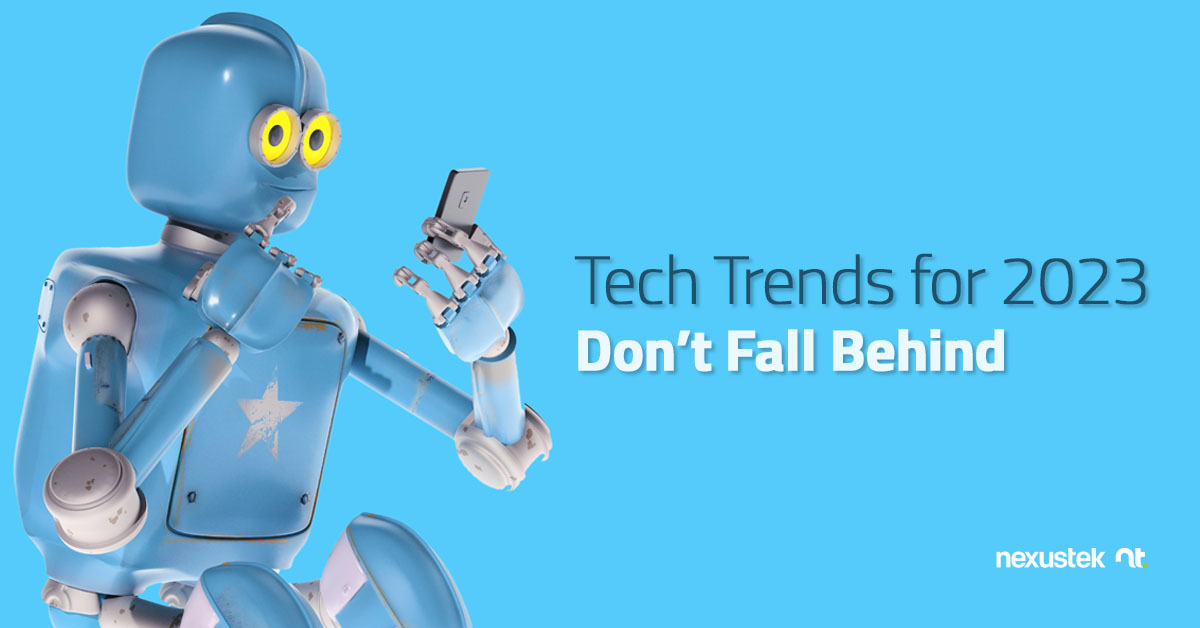READ TIME: 4 MIN

Tech Trends for 2023: Don’t Fall Behind
Welcome to 2023, and we hope your New Year is off to a wonderful start!
No technology blog would be complete without its annual “Tech Trends” article, so we’ve looked into our crystal ball to discover what we predict will be some of the most impactful trends in technology in the coming year. We hope you find this informative and that your business has a stellar 2023!
Sustainability continues to grow in importance to both consumers and businesses, with 90% of businesses now adopting some form of environmental, social, and governance (ESG) practices1. Many consumers now make buying decisions based on a company’s ESG performance, and they have become shrewd evaluators of the authenticity of a firm’s stated commitment to sustainability. In fact, the term “greenwashing” has been coined in reference to ESG practices that appear disingenuous or of little practical benefit.
The perils of greenwashing have become so acute that Forrester projects that “greenwashing becomes a serious business risk” in 20232. Technology experts such as Gartner’s David Groombridge view IT as being at the center of effective sustainability programs, suggesting that firms adopt a “sustainable by default” policy for all technology decisions.
For businesses looking to improve their sustainability performance, migrating to the cloud is a logical place to start. Compared with on-premises IT infrastructure, cloud data centers make much more efficient use of energy due to factors like higher server usage levels, data center location, and hardware efficiency. What this means for an individual business is that they can obtain the same amount of computing power while consuming far less energy than they would with on-premises infrastructure. This makes cloud computing an ideal means of shrinking your carbon footprint.
As cloud computing has gained prevalence, many voices have expressed concern about the security of the cloud. Under the traditional perimeter-based cybersecurity model, a company grants trust to users located inside the business’ network, denying trust to those located outside of that perimeter. But where exactly is that perimeter if your workloads are in the cloud and your employees work from remote locations of their choice?
This is an excellent question, one that is underscored by the fact that 20% of companies report experiencing a security breach due to a remote worker3. The answer? We need a new paradigm of security: Zero-trust cybersecurity.
Zero-trust cybersecurity is not a single solution. It is a state of security that is established by using a collection of solutions that together function to protect a company’s infrastructure in its entirety. As business infrastructures grow ever more diffuse, different methods are needed to ensure that access is granted at appropriate levels and to the right people. Solutions such as multifactor authentication (MFA) and identity access management (IAM) function to support these objectives, using multiple criteria to verify users before granting access on a least-privilege basis.
You may have heard about solutions like endpoint detection and response (EDR) and mobile device management (MDM)–these security solutions also support a zero-trust cybersecurity program. Endpoint solutions like EDR and MDM enhance security by allowing a company’s IT team to remotely monitor for malicious activity and manage the wide range of devices used by today’s employees, such as mobile phones, laptops, and tablets.
Because employees often use a mix of company and personal devices, also known as bring-your-own-device (BYOD), it is important for IT to have the ability to establish administrative policies and monitor for malicious activity on any device connecting to the company network. Endpoint management solutions give IT departments this capability.
With ongoing inflation and a generally uncertain economic outlook for 2023, another overarching theme for many current tech trends is making the most efficient use of your technology tools.
Automation certainly falls under the efficiency umbrella, as it gives your company the capacity to manage a range of predictable and repetitive tasks using IT tools rather than employee power. Gartner predicts that by 2024, companies that have implemented large-scale automation may see cost reductions of up to 30%4.
For example, business process automation applications are great tools for automating workflows that consume large amounts of employee time. This not only frees up your employees to work on important tasks, but it also reduces the likelihood of data processing errors in key areas like customer orders, inventory, job applications, and other human resources documentation.
Another great way to increase IT efficiency is to eliminate unnecessary spending on applications. If this seems like a no-brainer, consider this: On average, about 33% of a business’ software spend goes unused. In other words, the average company wastes a good chunk of money on things like unused software licenses or redundant applications (e.g., paying subscriptions for three applications that all do basically the same thing)5.
Offering IT Spend and other strategic assessments, plus cybersecurity, cloud hosting, productivity & collaboration applications, and managed services, NexusTek has the expertise and tools you need to get ahead of the curve in 2023.
Interested in exploring new IT possibilities for your business?
References:
- Overby, S. (2022, December 5). CIOs get serious about sustainability. CIO. https://www.cio.com/article/415205/cios-get-serious-about-sustainability.html
- McLellan, C. (2022, November 2014). Tech in 2023: Here’s what is going to really matter. ZDNET. https://www.zdnet.com/article/tech-in-2023-weve-analysed-the-data-and-heres-whats-really-going-to-matter/
- Nicoletti, P. (2022, September 29). Remote work security statistics in 2022. CyberTalk.org. https://www.cybertalk.org/2022/09/29/remote-work-security-statistics-in-2022-2/
- Weston, M. (2022, December 7). Digital transformation trends in 2023. Information Age. https://www.information-age.com/digital-transformation-trends-in-2023-123500903/
- (2022). State of ITAM report. https://info.flexera.com/ITAM-REPORT-State-of-IT-Asset-Management